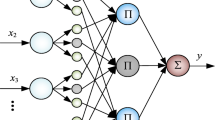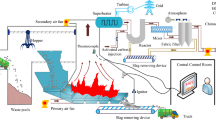Abstract
In this study, a self-organizing interval type-2 fuzzy neural network (SOIT2FNN) based on the Adaptive Quantum-behaved Particle Swarm Optimization (AQPSO) algorithm is proposed as a solution to the soft sensor modeling problem of effluent total phosphorus in the wastewater treatment process. An AQPSO algorithm is proposed to train and optimize the SOIT2FNN soft sensor model's structure and parameters in order to improve forecasting accuracy. Firstly the number of rules and parameters of SOIT2FNN are mapped to the spatial position of each particle of AQPSO, which is convenient for the parameter and structure optimization of the network model. The weighted average optimal position and the adaptive shrinkage coefficient are introduced in order to enhance the global search ability of PSO and ensure the robustness and convergence of the algorithm during the optimization process. By dynamically adjusting the network structure, the network size of each particle approximates the network size of an ideal particle, thereby improving the search efficiency and optimization results of the model. Finally, the proposed AQPSO-SOIT2FNN was applied to the Mackey–Glass chaotic time series prediction and soft sensor modeling of total phosphorus in wastewater treatment effluent. The results of the experiments show that the proposed AQPSO-SOIT2FNN is capable of producing a relatively compact network topology with high identification and prediction accuracy. address uncertainty satisfactorily, which is computationally more implementable.













Similar content being viewed by others
Data availability
Data will be made available on request.
References
Dupas, R., Delmas, M., Dorioz, J.M., et al.: Assessing the impact of agricultural pressures on N and P loads and eutrophication risk. Ecol. Indic. 48, 396–407 (2015)
Jin, L., Zhang, G., Tian, H.: Current state of sewage treatment in China. Water Res. 66, 85–98 (2014)
Dürrenmatt, D.J., Gujer, W.: Data-driven modeling approaches to support wastewater treatment plant operation. Environ. Model. Softw. 30, 47–56 (2012)
Sun, W., Wang, J., Gao, S.: Soft-sensor modeling of PVC polymerizing process based on F-GMDH-type neural network algorithm. J. Sens. (2017). https://doi.org/10.1155/2017/7872030
Liu, J., Wang, Y., Zhang, Y.: A novel Isomap-SVR soft sensor model and its application in rotary kiln calcination zone temperature prediction. Symmetry 12(1), 167 (2020)
Jalee, E.A., Aparna, K.: Neuro-fuzzy soft sensor estimator for benzene toluene distillation column. Procedia Technol. 25, 92–99 (2016)
Safari, A., Hosseini, R., Mazinani, M.: Dynamic type-2 fuzzy time warping (DT2FTW): a hybrid model for uncertain time-series prediction. Int. J. Fuzzy Logic Intell. Syst. 21(4), 338–348 (2021)
Nagarajan, D., Lathamaheswari, M., Kavikumar, J., et al.: Interval type-2 fuzzy logic washing machine. Int. J. Fuzzy Logic Intell. Syst. 19(4), 223–233 (2019)
Lin, Y.Y., Chang, J.Y., Pal, N.R., et al.: A mutually recurrent interval type-2 neural fuzzy system (MRIT2NFS) with self-evolving structure and parameters. IEEE Trans. Fuzzy Syst. 21(3), 492–509 (2013)
Lin, C.M., Le, T.L.: PSO-self-organizing interval type-2 fuzzy neural network for antilock braking systems. Int. J. Fuzzy Syst. 19(5), 1362–1374 (2017)
Lin, Y.Y., Chang, J.Y., Lin, C.T.: A TSK-type-based self-evolving compensatory interval type-2 fuzzy neural network (TSCIT2FNN) and its applications. IEEE Trans. Ind. Electron. 61(1), 447–459 (2013)
Mohammadzadeh, A., Ghaemi, S.: A modified sliding mode approach for synchronization of fractional-order chaotic/hyperchaotic systems by using new self-structuring hierarchical type-2 fuzzy neural network. Neurocomputing 191, 200–213 (2016)
Han, H.G., Chen, Z.Y., Liu, H.X., et al.: A self-organizing interval type-2 fuzzy-neural-network for modeling nonlinear systems. Neurocomputing 290, 196–207 (2018)
Han, H.G., Li, J.M., Wu, X.L., et al.: Cooperative strategy for constructing interval type-2 fuzzy neural network. Neurocomputing 365, 249–260 (2019)
Han, H., Sun, C., Wu, X., et al.: Self-organizing interval type-2 fuzzy neural network using information aggregation method. IEEE Trans. Neural Netw. Learn. Syst. 34(9), 6428–6442 (2022)
El-Nagar, A.M., El-Bardini, M., Khater, A.A.: Recurrent general type-2 fuzzy neural networks for nonlinear dynamic systems identification. ISA Trans. 140, 170–182 (2023)
Salimi-Badr, A.: IT2CFNN: An interval type-2 correlation-aware fuzzy neural network to construct non-separable fuzzy rules with uncertain and adaptive shapes for nonlinear function approximation. Appl. Soft Comput. 115, 108258 (2022)
Castro, J.R., Castillo, O., Melin, P., et al.: A hybrid learning algorithm for a class of interval type-2 fuzzy neural networks. Inf. Sci. 179(13), 2175–2193 (2009)
Sun, C., Wu, X., Han, H.: An interval type-2 fuzzy neural network with multi-gradient learning for wastewater treatment process. In: 2023 42nd Chinese Control Conference (CCC), pp. 1223–1228. IEEE (2023)
Huang, S., Chen, M.: Constructing optimized interval type-2 TSK neuro-fuzzy systems with noise reduction property by quantum inspired BFA. Neurocomputing 173, 1839–1850 (2016)
Umoh, U., Udoh, S., Isong, E., et al.: PSO optimized interval type-2 fuzzy design for elections Results Prediction. Int. J. Fuzzy Logic Intell. Syst. 9, 1–19 (2019)
Lin, C.J., Jeng, S.Y., Lin, H.Y., et al.: Design and verification of an interval type-2 fuzzy neural network based on improved particle swarm optimization. Appl. Sci. 10(9), 3041 (2020)
Mao, W.L., Hung, C.W.: Type-2 fuzzy neural network using grey wolf optimizer learning algorithm for nonlinear system identification. Microsyst. Technol. 24(10), 4075–4088 (2018)
Cho, K.B., Wang, B.H.: Radial basis function based adaptive fuzzy systems and their applications to system identification and prediction. Fuzzy Sets Syst. 83(3), 325–339 (1996)
Wu, S., Er, M.J.: Dynamic fuzzy neural networks-a novel approach to function approximation. IEEE Trans. Syst. Man Cybern. Part B 30(2), 358–364 (2000)
Zhou, H., Zhang, Y., Duan, W., et al.: Nonlinear systems modelling based on self-organizing fuzzy neural network with hierarchical pruning scheme. Appl. Soft Comput. 95, 106516 (2020)
Wang, N., Er, M.J., Meng, X.: A fast and accurate online self-organizing scheme for parsimonious fuzzy neural networks. Neurocomputing 72(16–18), 3818–3829 (2009)
Dhahri, H., Alimi, A.M.: The modified differential evolution and the RBF (MDE-RBF) neural network for time series prediction. In: The 2006 IEEE International Joint Conference on Neural Network Proceedings, pp. 2938–2943 (2006)
Wang, N.: A generalized ellipsoidal basis function based online self-constructing fuzzy neural network. Neural Process. Lett. 34(1), 13–37 (2011)
Kim, J., Kasabov, N.: HyFIS: adaptive neuro-fuzzy inference systems and their application to nonlinear dynamical systems. Neural Netw. 12(9), 1301–1319 (1999)
Gaxiola, F., Melin, P., Valdez, F., et al.: Optimization of type-2 fuzzy weights in backpropagation learning for neural networks using GAs and PSO. Appl. Soft Comput. 38, 860–871 (2016)
Almaraashi, M., John, R.: Tuning of type-2 fuzzy systems by simulated annealing to predict time series. In: Proceedings of the world Congress on Engineering, pp. 976–980 (2011)
Juang, C.F., Huang, R.B., Cheng, W.Y.: An interval type-2 fuzzy-neural network with support-vector regression for noisy regression problems. IEEE Trans. Fuzzy Syst. 18(4), 686–699 (2010)
Gaxiola, F., Melin, P., Valdez, F., et al.: Generalized type-2 fuzzy weight adjustment for backpropagation neural networks in time series prediction. Inf. Sci. 325, 159–174 (2015)
Wu, S., Er, M.J., Gao, Y.: A fast approach for automatic generation of fuzzy rules by generalized dynamic fuzzy neural networks. IEEE Trans. Fuzzy Syst. 9(4), 578–594 (2001)
Sun, J., Feng, B., Xu, W.: Particle swarm optimization with particles having quantum behavior. In: Proceedings of the 2004 Congress on Evolutionary Computation, pp. 325–331 (2004)
Huang, G.-B., Saratchandran, P., Sundararajan, N.: An efficient sequential learning algorithm for growing and pruning RBF (GAP-RBF) networks. IEEE Trans. Syst. Man Cybern. Part B 34(6), 2284–2292 (2004)
Funding
This study was supported by the Research Initiation Fund Project of Liaoning Petrochemical University (Grant No. 2019XJJL-017).
Author information
Authors and Affiliations
Corresponding author
Rights and permissions
Springer Nature or its licensor (e.g. a society or other partner) holds exclusive rights to this article under a publishing agreement with the author(s) or other rightsholder(s); author self-archiving of the accepted manuscript version of this article is solely governed by the terms of such publishing agreement and applicable law.
About this article
Cite this article
Wang, P., Zhao, T., Cao, J. et al. Soft Sensor Modeling of Self-Organizing Interval Type-2 Fuzzy Neural Network Based on Adaptive Quantum-Behaved Particle Swarm Optimization Algorithm. Int. J. Fuzzy Syst. (2024). https://doi.org/10.1007/s40815-024-01701-7
Received:
Revised:
Accepted:
Published:
DOI: https://doi.org/10.1007/s40815-024-01701-7




